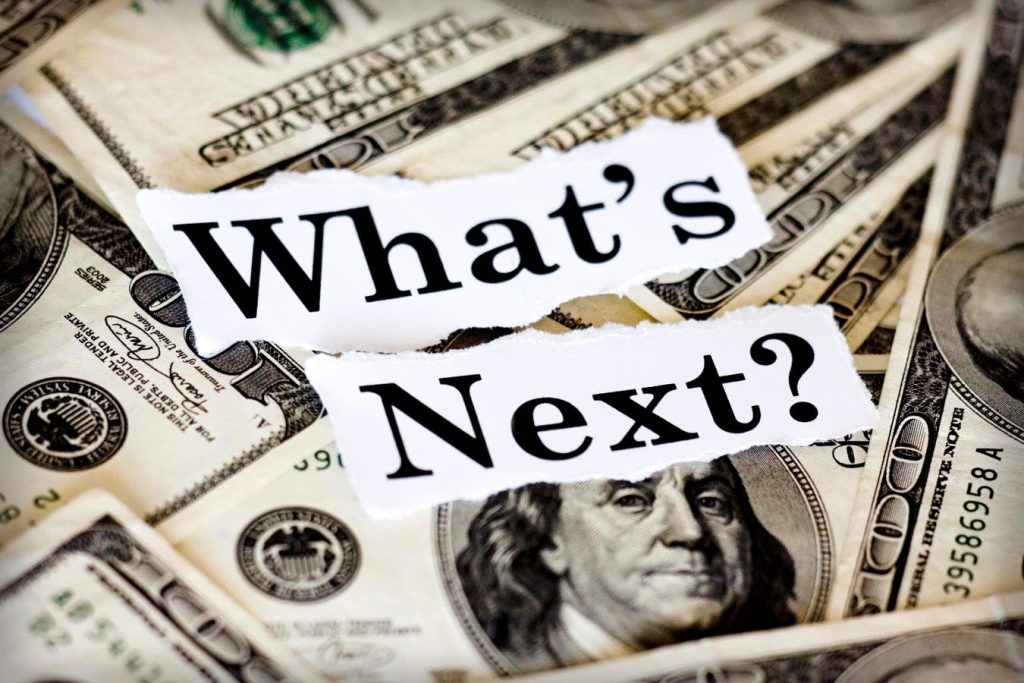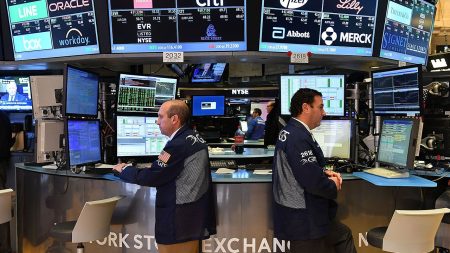There are three very clear signs the stock-market bull will keep stampeding. Let’s dive into them, then talk about two discounted funds set to ride those gains (and pay us rich dividends up to 11.4% in the process).
Bullish Signal #1: The US Worker is Strong
There’s a lot of pessimism about the US economy out there, even though it’s doing well. We’ve discussed why this is before—it’s ultimately due to the media getting more pessimistic—but this chart proves the point.
Since the Federal Reserve started tracking workers’ average weekly earnings in 2006, they’ve risen at a steady rate of about 2.6% annualized from then to 2020. Then earnings rose 5.4% per year after that and kept climbing. Since we’re talking earnings over the last four years, this isn’t due to pandemic stimulus alone; it’s a genuine change in the labor market.
To see it in action, look at the red line above. That’s the percentage of Americans who are in the labor force, and it’s been falling since 2000 (yes, 24 years!). In other words, working Americans were earning more per person, sure, but the total pool of Americans actually working shrank. That dynamic was an overhang on the country’s economy.
But now it’s gone, and instead more Americans are working and earning money. Economists have been ignoring this trend for a long time and are only now starting to realize it’s a big deal for consumer spending.
Since late 2023, economists have been feverishly updating their expectations as the data looks better and better. The secret is out: Americans are growing their wealth, and they’re spending more as a result.
Bullish Signal #2: Trillions of Dollars Remain on the Sidelines
The exchange of goods and services is encouraged more in America than anywhere else on Earth. This means that, over time, the total amount of wealth in the country grows as all the assets Americans own gain value.
But since the pandemic we’ve seen more of that wealth stay in cash.
The $6.4 trillion currently sitting in money-market funds is unusual, since it accompanies the 26% gain in stocks in the last year. Usually money-market assets go down when stocks go up. But now both are going up.
The reason? It’s twofold: First, Americans are dealing with rising prices on everyday purchases. Cryptocurrencies and other speculative investments have also burned some folks, and house prices are starting to fall in parts of America (more on that in a bit).
All this idle cash is bullish for stocks. Stocks rise when inflation goes up, but stocks haven’t risen much in the recent bout of inflation. Instead, they’ve spent two full years below their last peak. They’re now starting to recover.
When you consider just how much money remains on the sidelines, stocks’ slow recovery makes sense. It also suggests there’s more room to rise, especially since the alternatives to stocks aren’t doing so well. Enter real estate …
Bullish Signal #3: Real Estate Investing Is Off the Table for Many
American wealth is largely built on home equity, and to build home equity, you need three things:
- To own a house.
- Real estate prices to keep rising.
- Interest rates to remain lower than price gains.
Unfortunately, home prices are falling in almost half of the US and for a pretty obvious reason: Mortgages are too expensive. As a result, we’ve seen the median monthly mortgage payment more than double in the last decade and rise by nearly half in just the last two years!
For much of the last decade, rising housing costs have been the result of higher home prices. But that’s changed, with higher interest rates now the main cost driver. Buyers now have to spend more to borrow, and that’s restricted the number of buyers, especially since so few people buy their homes with cash.
This is why professional investors have been piling more into stocks than real estate lately. More of the broader public will likely follow, with the trillions of dollars they’re sitting on.
What’s more, we’ve got more Americans expecting stock prices to rise after years of unusually bearish sentiment, as you can see on the right side of the chart below.
Stocks, especially oversold stocks, are the obvious play in such a market. But those of us who favor closed-end funds (CEFs) can do better, grabbing oversold stocks with an “extra” discount and a big dividend thrown in.
Our Play: 2 “Double-Discounted” Dividends to Buy as Investors Return to Stocks
Our first pick is the Gabelli Equity Trust (GAB), which pays that 11.4% yield. It supports its payout in large part by strategically selling stocks in its portfolio.
In other words, GAB “translates” the gains from its holdings into cash for us, saving us the step of having to time our buys and sells on our own. Mario Gabelli, a renowned value investor in the mold of Warren Buffett, deftly handles this for us.
As you’d expect from a value-focused fund like GAB, its holdings consist of blue-chip companies like Mastercard (MA), American Express (AXP) and Deere & Co. (DE). A good way to look at GAB is as a play on strong stocks with healthy cash flows that have been overlooked in all the hype around NVIDIA (NVDA) and tech.
The fund trades at a 2.3% premium to net asset value (NAV)—another way of saying its price is 2.3% higher than its portfolio value. But don’t let that put you off, since this one typically trades at premiums much larger than that.
Our next play is for you if you want broad exposure to the S&P 500 but with less volatility: the Nuveen S&P 500 Dynamic Overwrite Fund (SPXX). This fund’s 7.3% dividend is extremely generous, given the S&P 500 pays about a fifth of that.
SPXX sells covered-call options on its portfolio. It then keeps the fees it charges investors for the right to make these trades, regardless of how they work out. It’s a canny way to reduce the fund’s volatility (since it gets more of its returns in cash) and support the payout.
Plus, SPXX owns the entirety of the S&P 500, so you’ll get upside from stocks’ steady climb and from the contraction of 8.5% SPXX’s discount, which tends to shrink in more volatile periods, which we’ll likely see in the shorter term, despite the market’s strong long-term prospects.
Michael Foster is the Lead Research Analyst for Contrarian Outlook. For more great income ideas, click here for our latest report “Indestructible Income: 5 Bargain Funds with Steady 10% Dividends.”
Disclosure: none
Read the full article here
















